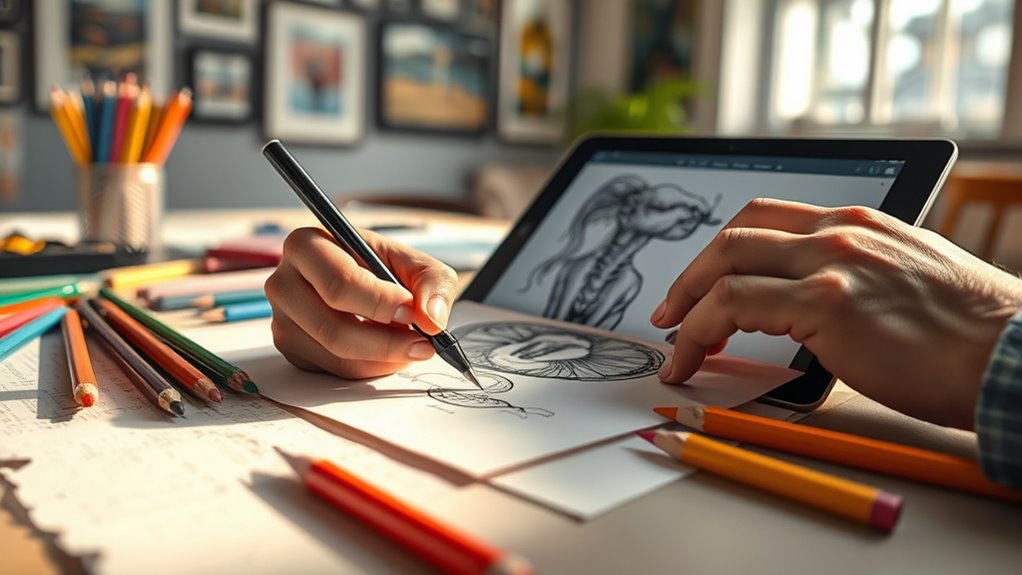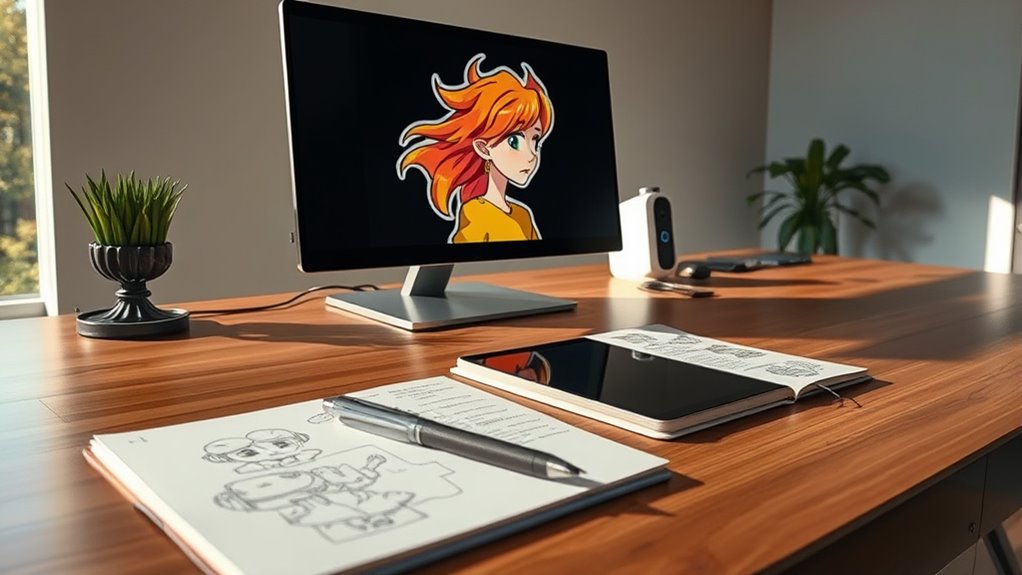Moral rights protect your personal connection to your creative work, ensuring you get proper attribution and that your artistic integrity remains intact. As an illustrator or graphic designer, these rights let you control how your work is used or altered and defend against unauthorized changes that could misrepresent your message. They also stay with you even if you sell or transfer rights. To learn how these rights influence your professional life, keep exploring further.
Key Takeaways
- Moral rights protect illustrators’ and designers’ personal connection to their work, emphasizing attribution and artistic integrity.
- These rights are personal and inalienable, remaining with creators even if the copyright is transferred or sold.
- Proper attribution ensures creators receive recognition and maintains the association between their name and their work.
- Moral rights safeguard against unauthorized modifications or distortions that could misrepresent or harm the creator’s reputation.
- Legal recognition of moral rights varies globally, reinforcing creators’ control over how their work is used and presented.

Have you ever wondered what makes certain rights in creative works so special? When it comes to illustrating or designing, your moral rights play an essential role in protecting your personal connection to your work. These rights are rooted in your authorship integrity, emphasizing that your creative voice remains intact and respected, even if the work is altered or used in different contexts. Unlike copyright, which mainly focuses on economic benefits, moral rights ensure that your personal and artistic reputation isn’t compromised. One key aspect of moral rights is attribution rights. These rights guarantee that you are properly credited for your creations, making sure your name stays associated with your work, no matter where it appears. This recognition isn’t just about pride; it’s about safeguarding your reputation and establishing your identity within the creative community.
Your moral rights ensure proper attribution and protect your personal connection to your creative work.
As an illustrator or graphic designer, you put a lot of effort, skill, and personal vision into each project. Your moral rights help preserve that personal touch, even when your work is commercialized or shared publicly. Imagine someone else modifies your illustration without your consent or fails to credit you—this can diminish your authorship integrity. Attribution rights are designed to prevent such issues, giving you legal leverage to insist on proper acknowledgment. These rights are especially important in a digital age where images are easily copied and redistributed, often without any regard for the original creator. By asserting your attribution rights, you maintain control over how your work is recognized and presented, reinforcing your role as the true author. Additionally, understanding the role of moral rights can help you better protect your creative identity in various jurisdictions.
It’s essential to understand that moral rights are often considered personal and inalienable, meaning they stay with you even if you sell or transfer the copyright. This personal connection to your work underscores the importance of authorship integrity—your right to control how your creative output is represented and used. Whether it’s ensuring your name appears prominently or preventing modifications that could distort your original message, these rights help uphold your artistic identity. Many countries recognize these moral rights by law, offering legal backing to protect your authorship integrity and attribution rights.
In essence, moral rights are about more than just legal protections—they’re about safeguarding your identity as a creator. They acknowledge that your work is an extension of yourself, deserving of respect and proper recognition. As an illustrator or designer, understanding and asserting these rights helps you maintain the personal and professional integrity of your creations. It ensures that your artistic voice remains authentic and that you, as the author, are rightfully acknowledged for your contributions. Protecting your moral rights isn’t just about legal compliance; it’s about honoring your role as a creative individual and preserving the integrity of your artistic journey.
Frequently Asked Questions
How Do Moral Rights Differ Internationally?
You’ll find that moral rights differ internationally mainly in how they’re enforced and their scope. In some countries, like France, moral rights are strongly protected and cannot be waived, while others, like the US, focus more on copyright exceptions and allow waivers. You should be aware that moral rights enforcement varies, so understanding local laws helps you protect your creative integrity across borders.
Can Moral Rights Be Waived or Transferred?
You can waive or transfer moral rights, but there are limitations. Waiver limitations mean you can choose to give up certain rights, often through a written agreement, though some moral rights are inalienable depending on the jurisdiction. Transfer procedures involve formal contracts that specify which rights are transferred and under what conditions. Always verify local laws to guarantee your waiver or transfer complies with legal requirements and protects your moral rights effectively.
What Remedies Exist for Moral Rights Violations?
Moral rights enforcement is like a shield, protecting your artistic integrity. If your moral rights are violated, you can seek remedies such as injunctions to stop the infringement, damages for harm caused, or even moral rights acknowledgment. These remedies aim to restore your reputation and control over your work. Act swiftly, consult legal counsel, and document violations to guarantee you effectively enforce your rights and uphold your creative integrity.
How Do Moral Rights Affect Commercial Use?
Moral rights protect your artistic integrity by ensuring your work isn’t altered or misused without your consent. When it comes to commercial use, you must adhere to attribution requirements, giving you credit for your creation. These rights limit how your work is used commercially, ensuring your reputation isn’t harmed. You retain control over how your art is presented, and violations can lead to legal remedies to defend your moral rights.
Are Moral Rights Applicable to Digital Artwork?
Digital artwork definitely falls under moral rights, even in the online domain. While digital authentication helps verify authorship, copyright enforcement ensures your moral rights are respected. You retain the right to object to modifications or misrepresentations that harm your reputation. So, whether your art is displayed on a website or shared across social media, your moral rights remain applicable, safeguarding your creative integrity in the digital age.
Conclusion
By grasping the gentle nuances of moral rights, you’ll find yourself better equipped to navigate the creative landscape. Respecting these rights isn’t just about legalities—it’s about honoring your own artistry and the integrity of your work. Embrace this understanding as a guiding light, subtly shaping your professional journey. When you value moral rights, you nurture a respectful and inspiring environment, allowing your creativity to flourish with confidence and grace.









